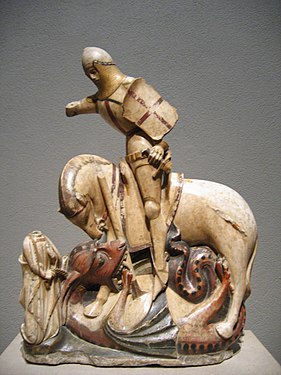Today is the Solemnity of St George.
St George and the Dragon
English tinted alabaster 1375-1420
National Gallery of Art Washington DC
Image: Wikipedia
Last year on this day I posted ...,,,, which records the later medieval story of St George. When he wrote it James of Voragine must have had access to much earlier accounts, but he chose to omit some of the more spectacullsr torments inflicted upon the Saint - tortured he successfully endured and survived over a period of seven years.
These stories are well summarised in an account I found quite by chance in, of all newspapers, The Sun - not the place you normally look for early medieval hagiography. The article can be seen at How St George overcame grisly torture of nails hammered into his skull, being boiled alive and drinking molten lead to become patron saint
The similar Coptic tradition about St George is set out at St. George, Prince of Martyrs and the one from Georgia, where his cult was not surprisingly widespread, at Martyrdom of the Great-martyr George of Georgia
There are some additional points about the story at two linked posts What does “magganum” mean? Looking for the Commentator Cruquianus of Horace and More on “Magganum” and St George
St George from s Book of Hours ?circa 1380
Image Wikipedia
There is a very good survey of the transmission of the stories in medieval England in particular in a 2004 article on The Martyrdom of St. George: Introduction | Robbins Library Digital Projects
There is an online introduction to the cult in late medieval England at ‘Cry God for Harry, England and Saint George!’: Saint George in Late Medieval England
The British Library Medieval Manuscripts blog has a post from last year about their holdings of material relating to the cult of St George and to the Order of the Garter at St George and the Garter
Wikipedia has two excellent articles about the cult of St George. The first is Saint George and the Dragon and the second at Saint George in devotions, traditions and prayers This also includes a gallery of some of the many paintings of the Saint. He has proved to be a very popular source of artistic commissions over the centuries which testifies to his appeal as a patron and exemplar.
St George by Donatello. Florence, 1415
Image: Wikipedia
St George Pray for us





No comments:
Post a Comment